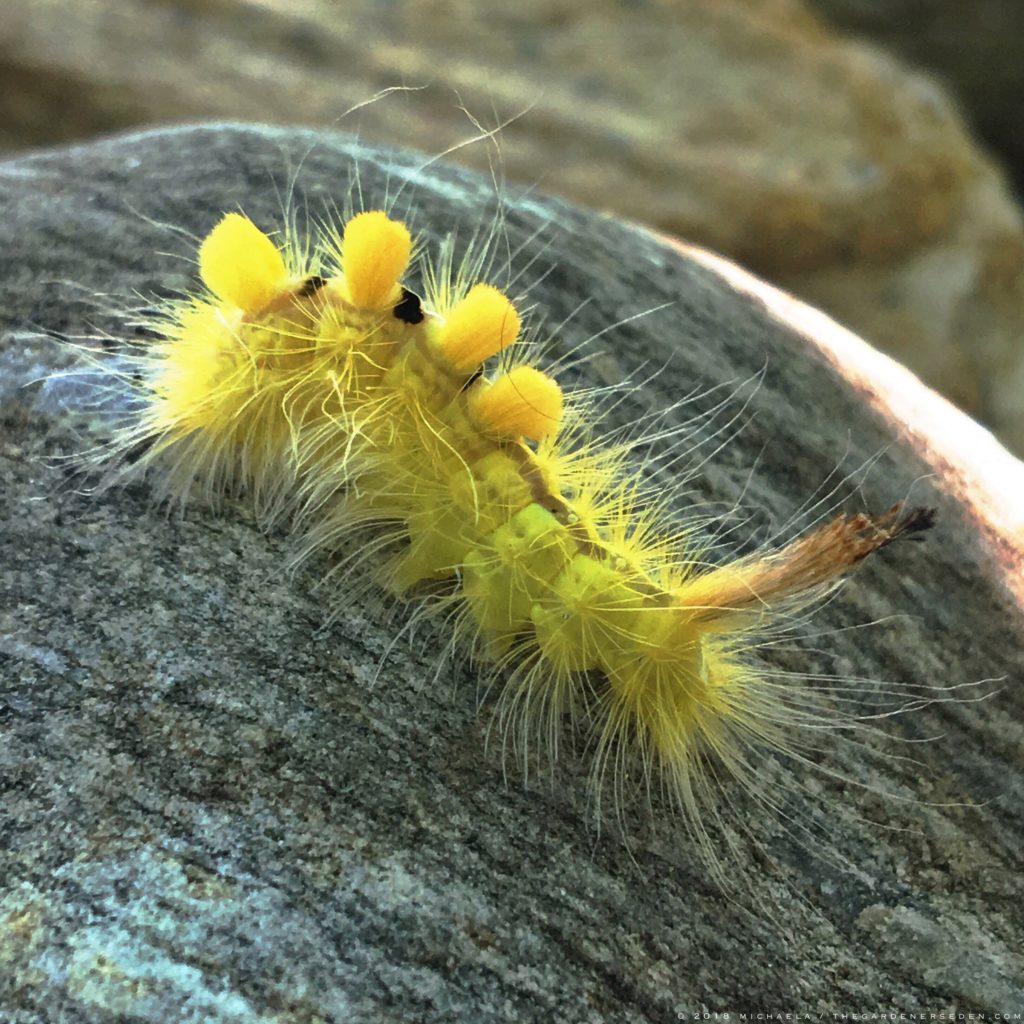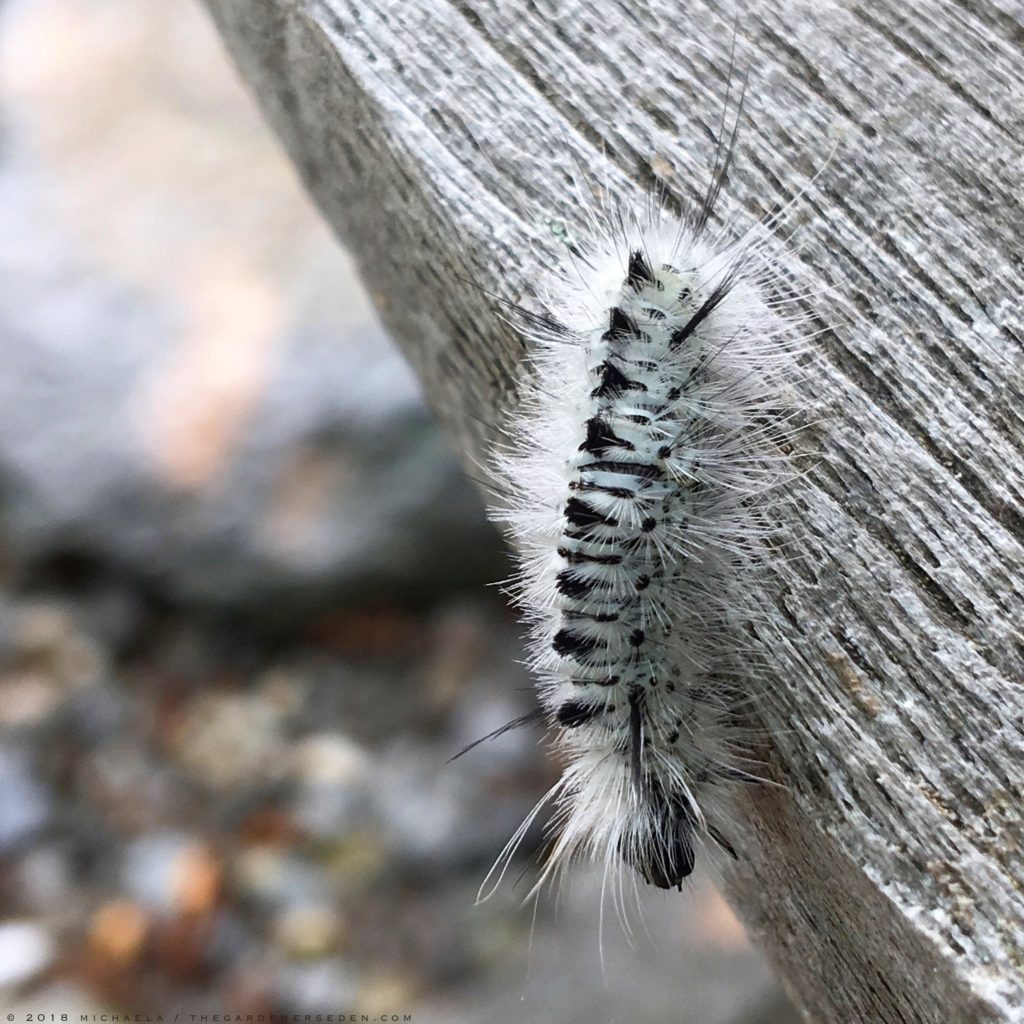Going Buggy: Let’s Talk About Tussock Moth Caterpillars
 On the Left, Hickory Tussock Moth Caterpillar (Lophocampa caryae), and on the Right, White-Marked Tussock Moth Caterpillar (Orgyia leucostigma)
On the Left, Hickory Tussock Moth Caterpillar (Lophocampa caryae), and on the Right, White-Marked Tussock Moth Caterpillar (Orgyia leucostigma)
Suddenly, it’s September, and everywhere I look, there are hints of a changing season. One of the first autumnal signs I’ve noticed this year is the appearance of fuzzy, colorful, and boldly-patterned Tussock Moth caterpillars. Although these hungry little critters do tend to skeletonize the foliage of certain trees, and sometimes, during large infestations, they can cause trouble with crop trees, their late-season noshing is usually a minor aesthetic issue, (Hickory Tussocks mainly munch deciduous elm, ash, oak, willow, nut and of course, hickory trees, while White-Marked Tussocks and Definite Tussock Moths, usually prefer apple, birch, elm, maple, cherry and sometimes conifers such as balsam fir and larch). However, the black and white, Hickory Tussock Moth Caterpillar (Lophocampa caryae, pictured atop, at left), has recently caught some bad press as a “venomous caterpillar”. So, what’s the scoop?
 The Definite Tussock Moth (Orgyia definita), is Easy to ID with its Yellow Head and Body, Black spots and White-Blond Hairs.Â
The Definite Tussock Moth (Orgyia definita), is Easy to ID with its Yellow Head and Body, Black spots and White-Blond Hairs.Â
Indeed, the spines of many Tussocks –including, but not limited to the black and white, Hickory Tussock Moth Caterpillar— do contain a venom to ward off predators. When handled, this venom can rub off on the skin, sometimes causing a red, stinging, itchy rash. For most people, the reaction is mild, and can be treated with ice and over-the-counter rash medication, however some individuals –particularly children and adults with sensitive skin– will experience more discomfort than others. For this reason, it’s best to avoid handling all Tussock Moth Caterpillars, unless wearing gloves. Most wild creatures do prefer to be left alone, so I try to simply observe and enjoy insects, and all other wild things, from a respectful distance, without touching or disturbing them at all.
For more information about Tussock Moths and their Caterpillars, visit BugGuide.net or MothAndCaterpillars.org.
 Look, But Don’t Touch! Some People Experience Allergic Reaction to Tussock Moth Caterpillar Venom. Avoiding Contact is the Best Defense. Most Creatures Prefer Not to be Handled Anyway.Â
Look, But Don’t Touch! Some People Experience Allergic Reaction to Tussock Moth Caterpillar Venom. Avoiding Contact is the Best Defense. Most Creatures Prefer Not to be Handled Anyway.Â
…
Article and Photography copyright Michaela at The Gardener’s Eden, all rights reserved. All content on this site, (with noted exceptions), is the property of The Gardener’s Eden and may not be used, reproduced or reposted elsewhere without written consent.
Do you enjoy visiting The Gardener’s Eden? You can help support this site by shopping through the affiliate-links here. A small percentage of each sale will be paid to The Gardener’s Eden, and will help with site maintenance and web hosting costs. Thank you!
.
4 Replies to “Going Buggy: Let’s Talk About Tussock Moth Caterpillars”
Comments are closed.

These are beautiful! We have a few varieties here in N. Alabama and also the dreaded Puss caterpillar. I leave them a wide berth and have never been ‘stung’. However, I nearly got one in the face one evening when it was hanging from a tree on a length of its silk! Glad my flashlight caught it before I did. ;)
Hi Lynda. YIKES! Puss Caterpillar? That sounds really unpleasant. Amazing what images that name conjures! I am very glad to hear that you avoided the sting. I’ve never suffered a Tussock Moth Caterpillar rash, but again, I rarely touch critters. Walk into them? Yes, that happens. I will hope I never walk into a Puss Caterpillar! XOX
If you haven’t already, here is some information on the Puss caterpillar (aka: flannel moth) https://news.nationalgeographic.com/news/2014/09/toupee-caterpillar-venomous-animal-weird-insect/
The spine’s sting is supposed to be worse than a bee sting. Thankfully, I have not encountered the venom so I can’t say it is true.
Yikes! Yikes! I think the cuddly-looking aspect is what confuses me. Crocodiles look scary. Scorpions look like they mean business. This guy? Reminds me of Monty Python and the Holy Grail’s infamous Killer Rabbit